80+ Basic Korean Travel Phrases – Phrases to Learn Before Visiting Korea

Getting around Korea these days is pretty easy – even if you know now Korean at all. There is a large amount of English signage, most menus have English captions, and many locals know at least basic English. It’s entirely possible to visit Korea without knowing any Korean.
However, knowing at least some basic Korean phrases will make your trip much easier. It’s also much more polite – if you’re visiting Korea you should at least try to learn and use some basic phrases. Not only that, but often locals will be impressed and very happy if you speak Korean – even if it’s only the simplest Korean!
Something that many people don’t realise is that learning the Korean alphabet (hangul) is actually extremely easy. If you set aside a few hours you can easily learn how to read. There are also some fantastic platforms out there to help such as 90 Day Korean and How To Study Korean.
If you don’t have the time to learn some basic Korean or would prefer to just know the vital Korean travel phrases, then this post is for you. In it, I cover basic phrases that you need to know. Everything from basic introductory phrases to asking if food is vegan is covered!
This article contains affiliate links. Affiliate links provide me with a percentage of purchases made from links on this page. This comes at no extra cost to you – for more information, please refer to my affiliate disclaimer.
Foreword
Please note that the Korean examples in this article may not be totally grammatically correct. While all of the sentences and phrases in this article make sense and will be understood, some of them aren’t perfect. This was done in order to make the phrases as easy to use as possible. It’s better to get an understandable sentence across than to worry about all of the details.
On top of this, Korean has respect levels that are very important to take into account. To avoid complications, I have only used the formal/semi-formal versions of words and phrases in this article. You can say all of these phrases without worry – it’s better to speak only formal than only informal!
Korean Sentence Structure
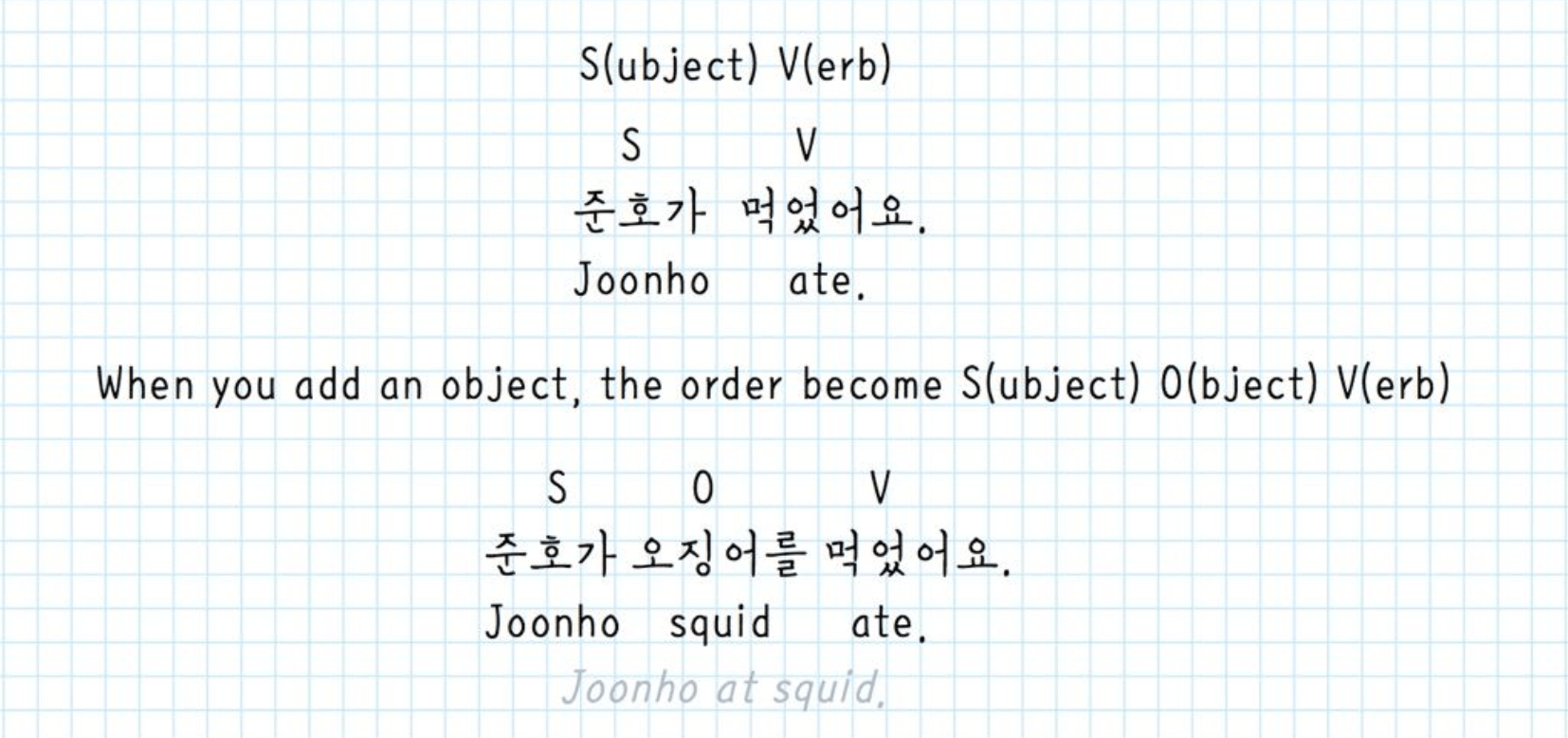
Image from this fantastic guide.
Before getting into the essential Korean travel phrases that you need to know, I want to briefly touch on Korean sentence structures. I am not a language expert and I don’t want to go too in-depth here, but I would like to mention the structural differences as it will help a lot throughout this article. If you do want to learn about Korean sentences in-depth, check out Glossika.
English follows the SVO (subject, verb, object) structure. In other words, an English sentence is formed like this:
I walked to school – I (subject) walked (verb) to school (object)
However, Korean sentences are formed using the slightly different SOV (subject, object, verb) structure. This can take a while to get used to and even today I forget sometimes!
저는 학교에 걸어요 – 저는 (subject) 학교에 (object) 걸어요 (verb) – I (subject) school (object) walked (verb).
This is a very simple sentence and in reality the differences are much more complex. However, knowing this difference will greatly help with your understanding of Korean in the future! It will also help to explain a lot of the sentences in this article.
Korean Phrases For Travel
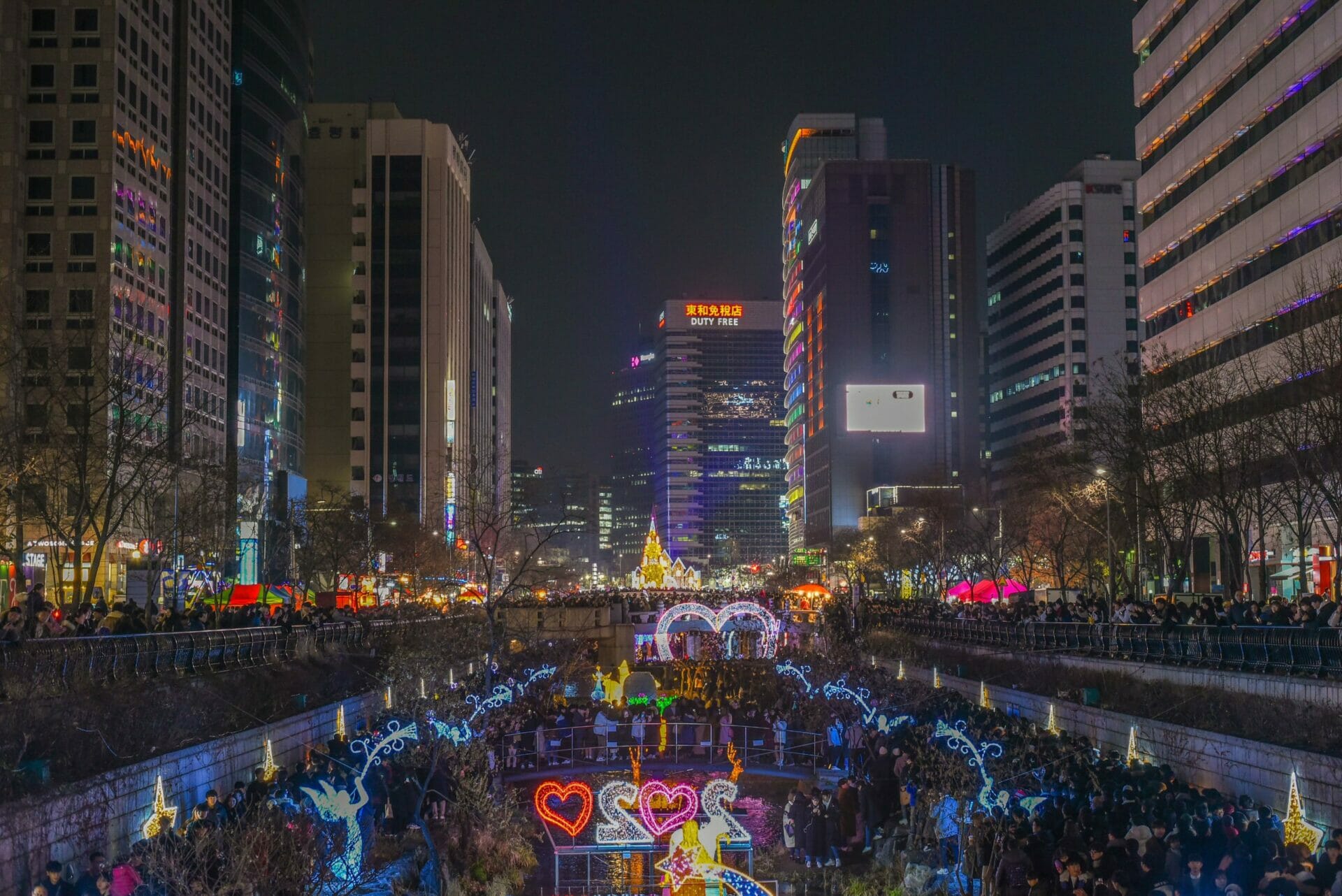
Basic Korean Introduction Phrases
1. Hello – 안녕하세요 – Ahn-yeong-ha-sae-yo
Hello – an essential in every language! 안녕하세요 (Ahn-yeong-ha-sae-yo) is a word that you will hear every day. It’s worth noting that while you should use 안녕하세요 for all adults, you can say 안녕 (ahn-yeong) to children or animals (if you sometimes say ‘hi’ to dogs like me!). This is the lower-formality level of ‘hello’.
Two interesting points about 안녕하세요. Firstly, it’s not used on the phone. If you are answering the phone, you should use 여보세요 (yeo-bo-sae-yo). However, make sure to only use it on the phone! Secondly, when entering restaurants, convenience stores, or other areas you will often hear 어서 오세요 (eo-seo o-sae-yo). This means ‘welcome’ and you can reply to it by saying 안녕하세요!
2. Goodbye – 안녕히 가세요/안녕히 계세요 – ahn-yeong-hi ga-sae-yo/ahn-yeong-hi gye-sae-yo
This is an interesting one as it often confuses people who are new to Korea. Korea’s standard goodbye has two forms, one for the person who is leaving and one for the person who is staying. For example, if you visit a friend’s house you would say 안녕히 계세요 when it’s time to leave (as you are leaving). They would say 안녕히 가세요 as they are staying.
안녕히 가세요 (ahn-yeong-hi ga-sae-yo) is for the person staying. However, if both people are leaving (say you went to watch a movie together and are now departing back to your houses) then both parties would say 안녕히 가세요. This may seem a bit confusing at first, but you’ll quickly get used to it!
3. Nice to Meet You – 만나서 반갑습니다 – Man-na-seo ban-gap-sueb-ni-da
This is the most common way to say ‘nice to meet you’ that you will find in Korea. 만나서 반갑습니다 (Man-na-seo ban-gap-sueb-ni-da) is very common and can be used whenever you are meeting someone for the first time. Some people will also just say 반갑습니다 – really, it’s up to you as either is fine.
4. My Name Is (name) – 제 이름은 (name)입니다 – Je ee-reum-eun (name) ib-ni-da
If you want to introduce yourself and tell someone your name you can simply put your name in the sentence 제 이름은 (name)입니다 (Je ee-reum-eun (name) ib-ni-da). For example, in my case I would say 제 이름은 Ethan입니다. Or, if I wanted to make it easier to pronounce I would say 제 이름은 이든입니다 (이든 = E-deun, or Ethan!)
5. I am from (country/city) – 저는 (country/city) 에서 왔어요 – jo-neun (country/city) ee-seo wass-eo-yo
If you want to tell someone where you are from then you can use the basic phrase 저는 (country/city) 에서 왔어요 (jo-neun (country/city) ee-seo wass-eo-yo). Korean tends to have its own words for countries, but cities usually have very similar names! I have included a table below with some countries – if I missed your country I am sorry, I had to keep the table somewhat manageable…
For me, I am from New Zealand. To tell someone where I am from I would simply add the word for New Zealand (뉴질랜드 – nyu-jil-laen-deu) to the sentence 저는 (country/city) 에서 왔어요. This would make my sentence 저는 뉴질랜드에서 왔어요
Korean Country Words
| United States | 미국 | mi-gug |
| United Kingdom | 영국 | yeon-gug |
| Germany | 독일 | dog-il |
| France | 프랑스 | pu-raeng-seu |
| China | 중국 | jung-gug |
| Japan | 일본 | il-bon |
| Australia | 호주 | ho-ju |
| Malaysia | 말레이시아 | mal-lae-i-si-a |
| Indonesia | 인도네시아 | in-do-ne-si-a |
| India | 인도 | in-do |
6. I am (age) years old – (age)살 입니다 – (age)sal ib-ni-da
There are a few different ways to introduce your age in Korean, but the simplest way is to say (age)살 입니다. What makes this a little bit more complicated is that you need to know a few Korean numbers – and Korea has two different counting systems. Luckily, you only need to know one for age. I have included the table of all numbers up to 100 below!
If you want to make a number like 27 just combine 20 (스물) with 7 (일곱). For example, 스물(20)일곱(7)살 입니다. Or, in English, I am 27. The same goes for every other number. If you happen to be an age that is a multiple of 10 you can just use the words directly from the table below.
Korean Numbers
| One | 하나 | ha-na |
| Two | 둘 | dul |
| Three | 셋 | set |
| Four | 넷 | net |
| Five | 다섯 | da-sot |
| Six | 여섯 | yeo-sot |
| Seven | 일곱 | il-gob |
| Eight | 여덟 | yeo-deolb |
| Nine | 아홉 | a-hob |
| Ten | 열 | yeol |
| Twenty | 스물 | seu-mul |
| Thirty | 서른 | seo-reun |
| Forty | 마흔 | ma-heun |
| Fifty | 쉰 | swin |
| Sixty | 예순 | ye-sun |
| Seventy | 일흔 | il-heun |
| Eighty | 여든 | yeo-deun |
| Ninety | 아흔 | a-heun |
| One Hundred | 백 | baek |
8. How are you? – 어떻게 지내세요? – eo-tteoh-gae ji-nae-se-yo?
How are you (어떻게 지내세요) is a word that you probably won’t want to use when visiting Korea. However, I know people will ask so I included it. With that being said, you shouldn’t use it unless you are meeting an old friend.
The phrase ‘how are you’ is not something that is really used in Korea – and definitely not with strangers. If you are meeting a friend who you have met before, however, it’s okay to ask. While 어떻게 지내세요 is a more direct translation, 잘 지내세요 (jal ji-nae-se-yo) is more commonly used and it literally means ‘have you been well?’.
9. I am (profession/job) – 저는 (profession/job)입니다 – joe-neun (profession/job) ib-ni-da
If you want to express your profession or job then 저는 (profession/job)입니다 is the easiest Korean phrase to use. You can put a variety of words in the gap. For me, I usually put the word ‘student’ there as I am a student at Korea University! The word for ‘student’ is 학생 (hag-saeng), so I would say 저는 학생입니다. I’ve included a short table with some common jobs below!
Korean Professions
| Artist | 예술가 | ye-sul-ga |
| Entrepreneur | 사업가 | sa-eob-ga |
| Chef | 요리사 | yo-ri-sa |
| Dentist | 치과의사 | chi-gwa-ui-sa |
| Doctor | 의사 | ui-sa |
| Lawyer | 변호사 | byeon-ho-sa |
| Nurse | 간호사 | gan-ho-sa |
| Photographer | 사진사 | sa-jin-sa |
| Reporter | 기자 | gi-ja |
| Student | 학생 | hak-saeng |
| Unemployed | 백수 | baek-su |
10. I’ve been in Korea for (time) – 한국에 온 지 (time) 됐어요 – han-gug-ae on ji (time) dwaess-eo-yo
Whether you’ve been in Korea for one month, one week, one day, or even only one hour you might want to tell someone! This sentence is a little bit more complicated as you also need to know some words like hour, day, week, month, and year. However, the basic sentence structure is 한국에 온 지 (time) 됐어요.
To use this sentence properly you will want to say 한국에 온 지 (number + counter) 됐어요. For example, if you have been in Korea for one week you will want to say the number 1 (일) + the word for week (주) therefore, the complete sentence would be 한국에 온 지 일주 됐어요.
Korean Time Words
| Hour | 시 | si |
| Day | 일 | il |
| Week | 주 | ju |
| Month | 월 | weol |
| Year | 년 | nyeon |
11. I study (major) – 제 전공은 (major)입니다 – je Jeon-gong-eun (major) ib-ni-da
This one might seem a bit unusual at first, but if you are younger you will likely be asked what you study or what your major is. Education is very important in South Korea, and you can expect to see and hear a lot about it. For that reason, knowing how to say your major is very helpful!
There are a ton of majors and I can’t include them all. However, I’ve included some common majors below. To complete the sentence, simply insert your major in 제 전공은 (major)입니다. For example, if you study political science (정치학 – jeong-chi-hak) then you can say 제 전공은 정치학입니다!
Korean University Majors
| Engineering | 공학 | gong-hag |
| Education | 교육학 | gyo-yug-hag |
| History | 역사교육학 | yeog-sa-gyo-yug-hag |
| Physics | 물리교육학 | mul-li-gyo-yug-hag |
| Chemistry | 화학교육학 | hwa-hag-gyo-yug-hag |
| Biology | 생물교육학 | saeng-mul-gyo-yug-hag |
| Computer Science | 컴퓨터공학 | keom-pyu-teo-gong-hag |
| Philosophy | 철학 | cheol-hag |
| Economics | 경제학 | gyeon-je-hag |
| Statistics | 통계학 | tong-gye-hag |

General Korean Phrases
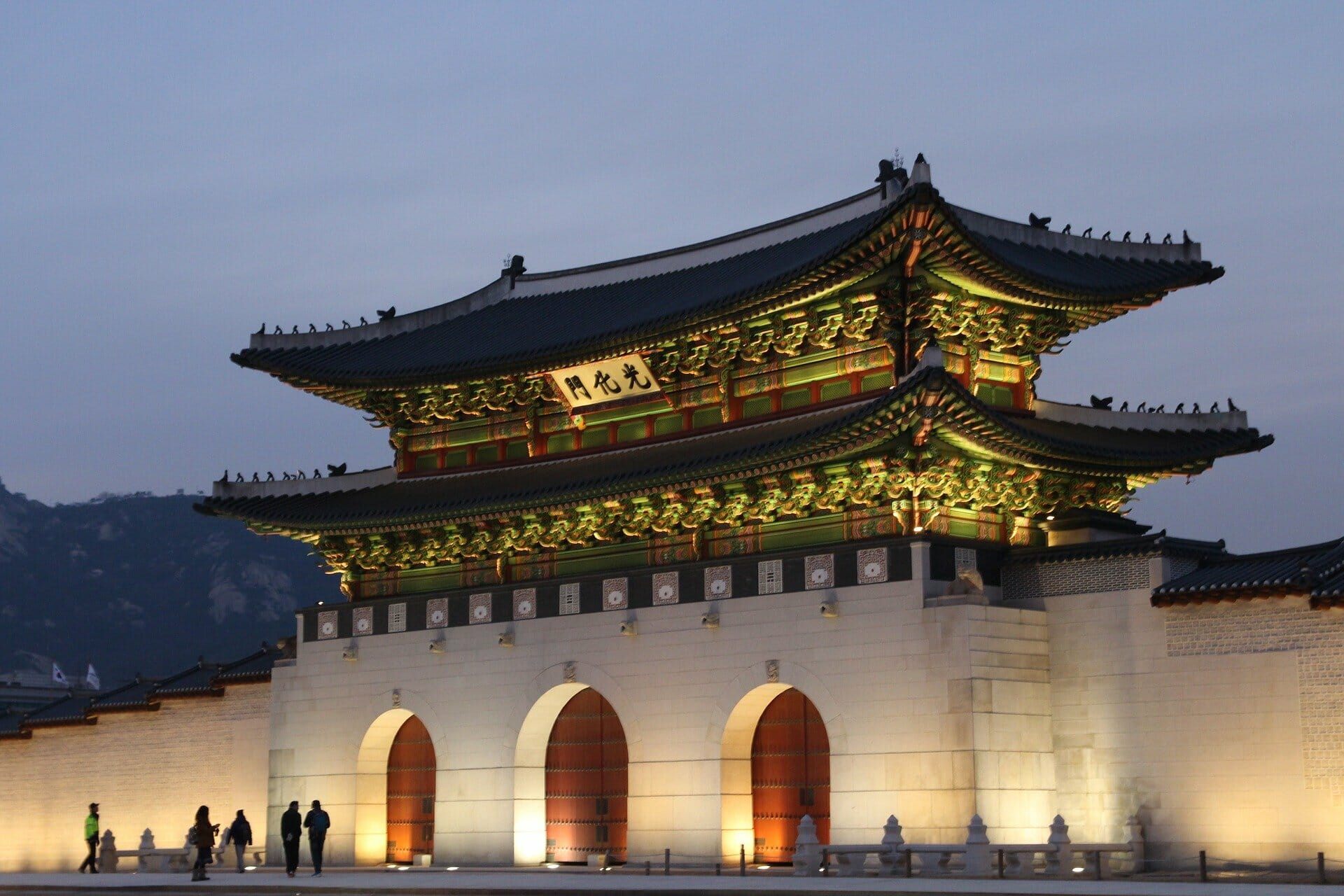
12. Yes – 네 – ne
Yes, or 네 in Korean is a word that you definitely should know (it’s also worth knowing ‘no’!). While there are many ways to say yes, 네 is the most common. The term most simply means yes and shows agreement. While all you need to know is 네, you may also see 예 (ye). This is very handy because it sounds similar to ‘yeah’ in English and it’s also formal!
13. No – 아니요 – a-ni-yo
아니요 simply means no! There’s not much more to it.
14. Thank you – 감사합니다 – gam-sa-hab-ni-da
감사합니다 is the most common form of ‘thank you’ that you will hear every day in Korea. You can use it in almost all of the same situations that you would in English. However, foreigners in Korea tend to use it a lot more than locals.
15. Excuse me – 실례합니다 – sil-lye-hab-ni-da
If you find yourself in a situation where you need to say ‘excuse me’, for example, if you need to push past someone on Seoul’s fantastic public transport, you can simply say 실례합니다!
16. I understand – 알겠습니다 – al-gess-seub-ni-da
알겠습니다 shows that you have understood something or that you agree with it. For example, if you were to ask for directions you could say 알겠습니다 to show that you have understood what the other speaker said.
17. I don’t understand – 잘 모르겠어요 – jal mo-reu-gess-eo-yo
If you don’t understand something that someone has said, you can say 잘 모르겠어요! This simply indicates that you don’t understand what the other person is saying or has said.
18. Wait a second – 잠시만요 – jam-si-man-yo
잠시만요 is one of my favourite Korean words. It’s extremely useful and means something along the lines of ‘wait a second’ or ‘wait a minute’. If you need a minute to look at the menu before ordering, or if you need a second to get out your phone to translate a word, you can say 잠시만요!
19. I don’t speak Korean – 전 한국말 할 줄 몰라요 – jeon han-gug-mal hal jul mol-la-yo
20. Do you speak English? – 영어 할 줄 아세요? – yeong-eo Hal jul a-se-yo
21. I like (thing) – (thing) 좋아해요 – (thing) joh-a-hae-yo
If you would like to say that you like a thing, person, or otherwise, you can just add 좋아해요 after any word! If you don’t know the name of the item, but can see it, you can say ‘이것 좋아해요’ (I like this).
22. I don’t like (thing) – (thing) 좋아하지 않아요 – (time) joh-a-ha-ji ahn-a-yo
On the other hand, you can also say that you don’t like something by putting any word before 좋아하지 않아요. This does not mean that you hate something, just that you don’t like it.
23. Please give me (item) – (item) 주세요 – (item) ju-se-yo
주세요 is a very important word and probably one of the five most important Korean words to know before coming to Korea. It simply means ‘give me’ and you can use it after almost any word. While in English ‘please’ is often said, you can omit this in Korean.
주세요 will be covered in more detail in the cafe & restaurant phrases section as it’s very important in those cases!
24. Are you okay? – 괜찮아요? – gwaen-chan-a-yo?
When asking someone if they are okay, you can 괜찮아요? To make it a question, just raise your intonation towards the end of the word. The ‘yo’ at the end of the word should be emphasised to turn the word into a question. Otherwise, it just means ‘I am okay’.
25. I am okay – 괜찮아요 – gwaen-chan-a-yo
26. I am sorry – 죄송합니다 – chwae-seong-hab-ni-da
27. I don’t know – 몰라요 – mul-la-yo
28. Good – 좋아요 – joh-a-yo
While 좋아요 usually means ‘good’ it can also be used to show agreement. For example, if your friend asks you if you want to go to the cinema to see a movie you can reply simply with ‘좋아요’. This means ‘good!’ but in this case can be interpreted as ‘yes!’
29. Take care – 잘 지내세요 – jal jin-nae-se-yo
This means ‘live well’ and it isn’t often used in the same situation that ‘take care’ is in English. However, you may still want to use it and it is probably the closest translation of ‘take care’. If you won’t be seeing someone for a long time, 잘 지내세요 is a nice phrase to use.
30. What is this? – 이게 뭐예요? – I-ge mwo-ye-yo?
A very universal phrase, 이게 뭐예요 can be used to ask what anything is! Just make sure to also point at the thing in question to make sure that you are understood.
Korean Phrases for Restaurants & Cafes
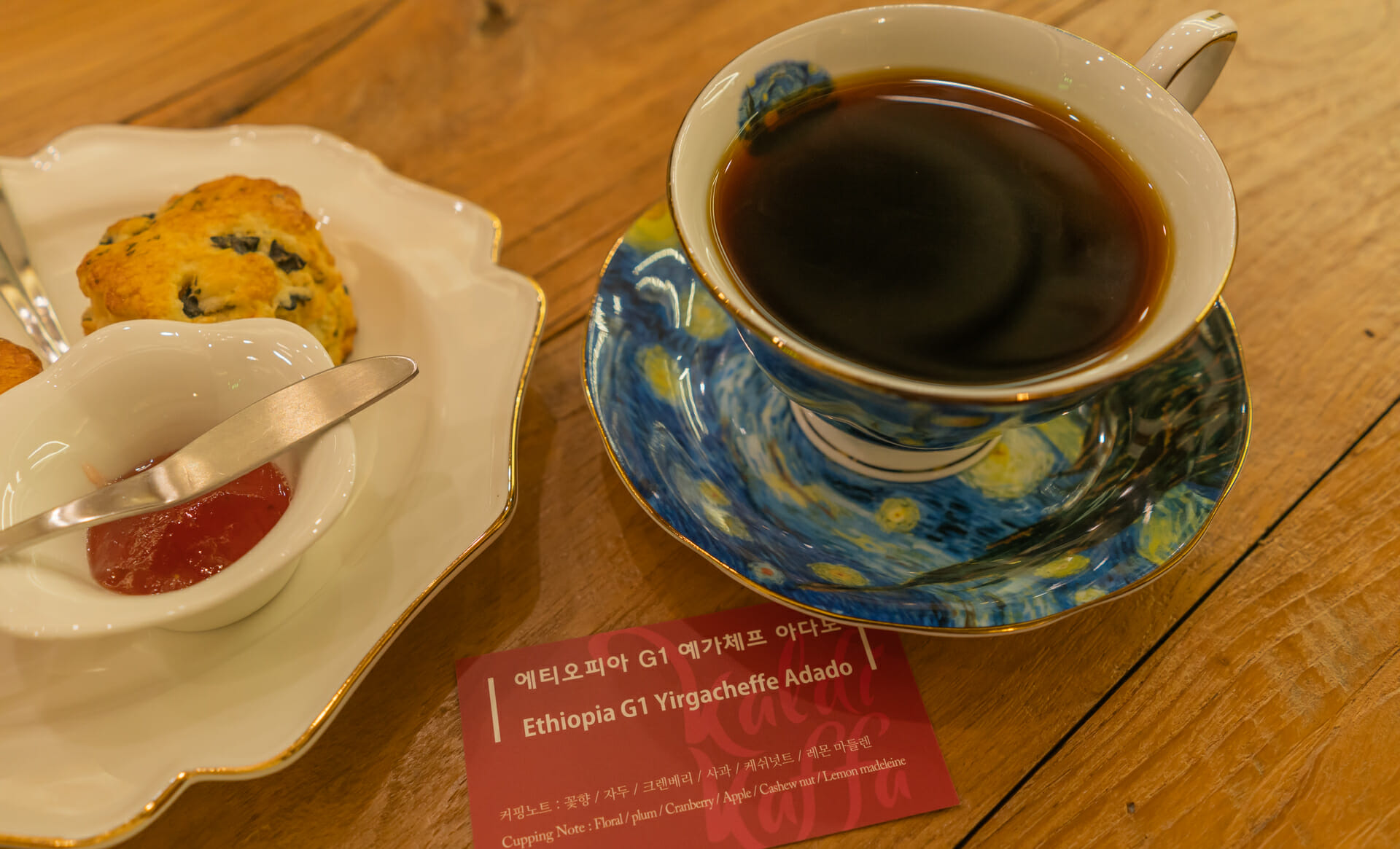
The below three sentences will allow you to ask if a cafe or restaurant has an item or dish. If they do, you can then go ahead and ask to order it! Korea has a fantastic coffee culture, so I highly recommend checking out some of the fantastic cafes in Seoul and other cities.
31. Can I have (item)? – (Item) 주세요 – (Item) ju-sae-yo
주세요 simply means ‘give me’. However, while this may not should polite in English it’s the normal way to ask for something in Korean. You can use 주세요 with anything that you need at a cafe or restaurant.
32. Do you have (item)? – (item) 있나요? – (Item) iss-na-yo
Before asking for an item, you might want to ask if that store, restaurant, or cafe actually has it! For example, you can ask 라떼 (la-ddae) 있나요? in a cafe to ask if they sell lattes!
33. How much is (item)? – (item) 얼마에요? – (item) eol-ma-e-yo
‘How much is this’? is an extremely useful term. If you are unsure of the word for the item that you are asking about, and if the item is visible, you can just point at it and ask ‘이것 (I-goet) 얼마에요?’ which means ‘how much is this’?
Can I have (drink) – (drink) 주세요
| Americano | 아메리카노 | a-me-ri-ka-no |
| Latte | 라떼 | ra-tte |
| Espresso | 에스프레소 | es-eu-peu-re-so |
| Cappuccino | 카푸치노 | ka-pu-chi-no |
| Cafe Mocha | 카페모카 | ka-pe-mo-ka |
| Affogato | 아포가토 | a-po-ga-to |
| Green Tea | 녹차 | nok-cha |
| Cold Brew | 콜드 브루 | ko-ldeu beu-ru |
| (other) Teas | (_) 차 | cha |
| Milk Tea | 밀크티 | mil-keu-ti |
Luckily, you will notice that nearly all Korean coffee words are very similar to their English counterparts.
Can I have (item) – (item) 주세요
| Water | 물 | mul |
| Fork | 포크 | po-keu |
| Knife | 칼질 | kal-jil |
| Spoon | 숟가락 | sut-ga-rag |
| Chopsticks | 젓가락 | jot-ga-rak |
| Glass/cup | 잔 | jan |
| Serviette/Tissue | 휴지 | hyu-ji |
| Bill | 계산해 | gye-san-hae |
| More of _ * | _ 더 주시겠어요? | _ do ju-si-gess-eo-yo |
If you want more of something but you don’t know the word, you can just point at what you want more of and say 이것 더 주시겠어요? (I-goet deo ju-si-gess-eo-yo – can I have more of this?).
34. I would like (size/flavour/etc) – (size/flavour/etc) 주세요 – (size/flavour/etc) ju-sae-yo
Similar to asking for an item or product in the tables above, you can also use 주세요 to ask for a specific flavour or size (and much more) of an item.
35. To go/take out – 포장해주세요 – po-jang-hae-ju-sae-yo
If you want a coffee or some food to go then just use the phrase 포장해주세요! The server will instantly know that you want the product to go. Further, if you are using an ordering machine and you see the phrase it means that you are ordering to go.
36. I will eat here – 여기서 먹고 갈게요 – yeo-gi-seo meog-go gal-ge-yo
On the other hand, if you want to eat/drink in you can 여기서 먹고 갈게요 to show that you intend to enjoy your meal/drink there!
37. Do you accept cash? – 현금 결제 되나요? – hyeon-geum gyeol-je dwi-na-yo
Some places in Korea may only accept cards or mobile payments. If you are wondering if somewhere accepts cash, just ask 현금 결제 되나요? Alternatively, you can ask if a location accepts cards by asking 카드 (ka-deu) 결제 되나요?
If you are enjoying drinking on a night out you can say 건배 to mean cheers! While it’s not as common to say this in Korea, it can be handy to know.
38. Can I have the menu? – 메뉴판 좀 보여주시겠어요? – me-nyu-pan jom bo-yeo-ju-si-gess-eo-yo
While you normally won’t need to ask for the menu (often it will be already given to you or can be found on the wall), you can use 메뉴판 좀 보여주시겠어요? if needed.
39. Is this spicy? – 이게 맵나요? – I-ge maeb-na-yo
40. Make it not spicy – 안 맵게 해주세요 – an maeb-ge hae-ju-se-yo
If you want something to be specifically not spicy you can ask 안 맵게 해주세요 (essential please make it not spicy). If you a less spicy option (but potentially still spicy) you can say 덜 맵게 해주세요 (deol maeb-ge hae-ju-se-yo).
41. Does this have (food) in? – 여기에 (food) 이 들어있나요? – yea-gi-e (food) i deul-eo-iss-na-yo
If there is a specific food that you are trying to avoid eating, or perhaps that you are allergic to, you can ask 여기에 (food) 이 들어있나요? Just put the ingredient/food that you are wondering about in the gap.
42. I am allergic to (food) – 저는 (food) 알레르기가 있어요 – joe-neun (food) al-le-leu-gi-ga iss-eo-yo
If you want to let a restaurant or cafe know that you are allergic to something you can insert the food/ingredient from the table below into the blank.
Does this have (food) in (common allergies/foods that are avoided)
| Pork | 돼지고기 | dwae-ji-go-gi |
| Peanuts | 땅콩 | ttang-kong |
| Nuts | 견과류 | gyeon-gwa-ryu |
| Caffiene | 카페인 | ka-pe-ine |
| Dairy | 유제품 | yu-je-pum |
| Seafood | 해산물 | hae-san-mul |
| Alcohol | 술 | sul |
| Egg | 계란 | gye-ran |
| Wheat | 밀 | mil |
| Fish | 생선 | saeng-seon |
43. Is this (halal/vegan) – 이게 (halal/vegan) 인가요? – I-ge (halal/vegan) in-ga-yo
If you have specific dietary needs then you can use the words below and put them in the gap. For example, if you are looking for vegan food you can ask 이게 채식 인가요?
44. Do you have (halal/vegan food)? – (halal/vegan food) 가 있나요? – (halal/vegan food) ga iss-na-yo
If you would like to ask a restaurant if they have halal, vegan, vegetarian, or dairy-free food you can use the sentence _ 가 있나요? with a word or phrase from the table below.
Is this (halal/vegan/dairy free)
| Halal | 이슬람 | I-seul-ram |
| Vegetarian/Vegan | 채식 | chae-sik |
| Dairy free | 유제품이 없는 음식 | yu-je-pum-i eob-neun eum-sik |
45. Hey, excuse me! – 저기요 – Jeo-gi-yo
저기요 is a combination between ‘hey’ and ‘excuse me’ that should only be used in restaurants when you need service. If you are wanting to order more food, need a fork, or otherwise, you can call a waiter by yelling out 저기요!
잠시만요 (jam-si-man-yo) which literally means ‘wait a minute’, and 여기요 (yeo-go-yo, literally ‘here’) also work when you are in need of service.
46. I would like this – 이것으로 주세요 – I-goet-eu-ro ju-se-yo
If you want something that is in a cabinet or on the menu you can simply point to it and say 이것으로 주세요! I would like this!
47. What’s in this? – 여기 뭐가 들어갔나요? – yeo-gi mwo-ga deul-eo-gass-na-yo
여기 뭐가 들어갔나요 can be used to ask what ingredients or foods are in a dish. While the response is most likely to be in Korean, the phrase may be useful at times.
48. What is good/delicious here? – 여기 추천 메뉴가 있나요? – yeo-gi chu-cheon me-nyu-ga iss-na-yo
Visiting a restaurant or cafe but can’t decide what to order? Then you can ask what the waiter would recommend! Another way to ask a similar question is to say 보통 어떻게 주문하나요? (bu-tong eo-deohh-ge ju-mun-ha-na-yo) which literally means ‘what do people usually order?’.
49. Please bring me some water – 물 좀 주세요 – mul jom ju-se-yo
주세요 (give me) was already covered in detail above but it’s worth mentioning again as it’s very important!
50. Do you have any food without (ingredient) – 여기 (ingredient) 가 안들어간 음식이 있나요? – yeo-gi (ingredient) ga an-deul-eo-gan eun-sik-i iss-na-yo
If you need to avoid certain food or ingredient you can use the sentence 여기 (ingredient) 가 안들어간 음식이 있나요? Just place a word from the table below into the blank or search for the word online if it isn’t included.
| Pork | 돼지고기 | dwaejigogi |
| Peanuts | 땅콩 | ttangkong |
| Nuts | 견과류 | |
| Caffiene | 카페인 | kapeine |
| Dairy | 유제품 | yujepum |
| Seafood | 해산물 | haesanmul |
| Alcohol | 술 | sul |
| Egg | 계란 | gyeran |
| Wheat | 밀 | mil |
| Fish | 생선 | saengseon |
51. Don’t give me (food) – (food) 빼주세요 – (food) bae-ju-se-yo
This sentence might seem a bit out of place, however, I’ve found it to have one great use. Ordering sandwiches at Subway! (food) 빼주세요 is a simple way to say what vegetables you don’t want on your sandwich. Of course, this sentence has some uses outside of Subway too!
52. Cheers – 건배 – geon-bae

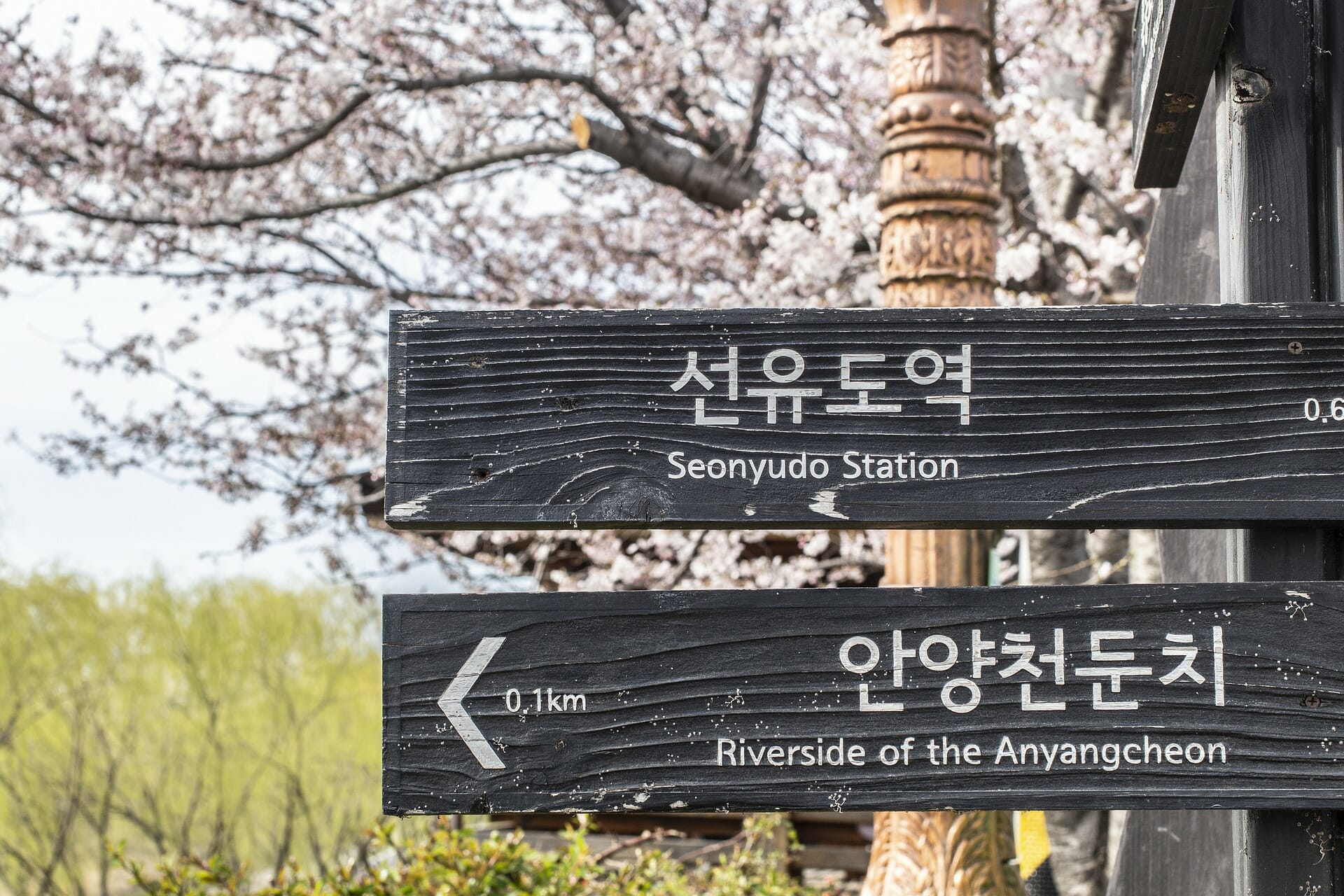
53. Where is (location)? – (location) 가 어디에 있나요? – (location) ga eo-di-e iss-na-yo
(location) 가 어디에 있나요? Is an easy-to-use sentence that will allow you to ask where any location is. Whether you are looking for the local metro station or a good place to shop it will work!
54. How can I get to (location)? – (location) 에 어떻게 가나요? – (location) e eo-deoh-ge ga-na-yo
55. Is there a (location) near here? – 여기 근처에 (location) 가 있나요? – yeo-gi gun-cho-e (location) ga iss-na-yo
Common Korean Location Names
| Subway Station | 지하철역 | ji-ha-cheol-yeog |
| Cinema | 영화관 | yeong-wha-gwan |
| Bus Stop | 버스정류장 | beo-seu-jeong-ryu-jang |
| Department Store | 백화점 | baek-wha-jeom |
| Pharmacy | 약국 | ya-gug |
| Hospital | 병원 | byeong-won |
| Post Office | 우체국 | u-che-gug |
| Convenience Store | 편의점 | pyeon-ui-jeom |
| Supermarket | 마트 | ma-teu |
| Market | 시장 | si-chang |
56. Take me to (location) – (location) 에 데려다 주세요 – (location) e de-ryeo-da ju-se-yo
If you are taking a taxi the the sentence (location) 에 데려다 주세요 will be very helpful. You can put a hotel name in the blank, or a subway station that you would like to go to.
57. Where is the closest subway station? – 여기서 제일 가까운 지하철역이 어디에 있나요? – yeo-gi-seo je-il ga-gga-un ji-ha-cheol-yeog-i eo-di-ae iss-na-yo
58. I am lost – 저 길을 잃었어요 – jeo jil-eul ilh-eoss-eo-yo
59. Where can I get a taxi? – 택시 어디서 타면 되나요? – taek-si eo-di-seo ta-myeon dwi-na-yo
60. Does this bus go to (location)? – 이 버스가 (location) 에 가나요? – I beo-seu-ga (location) e ga-na-yo
61. Does this train go to (location)? – 이 기차가 (location) 에 가나요? – I gi-cha-ga (location) e ga-na-yo
Korean Shopping Phrases
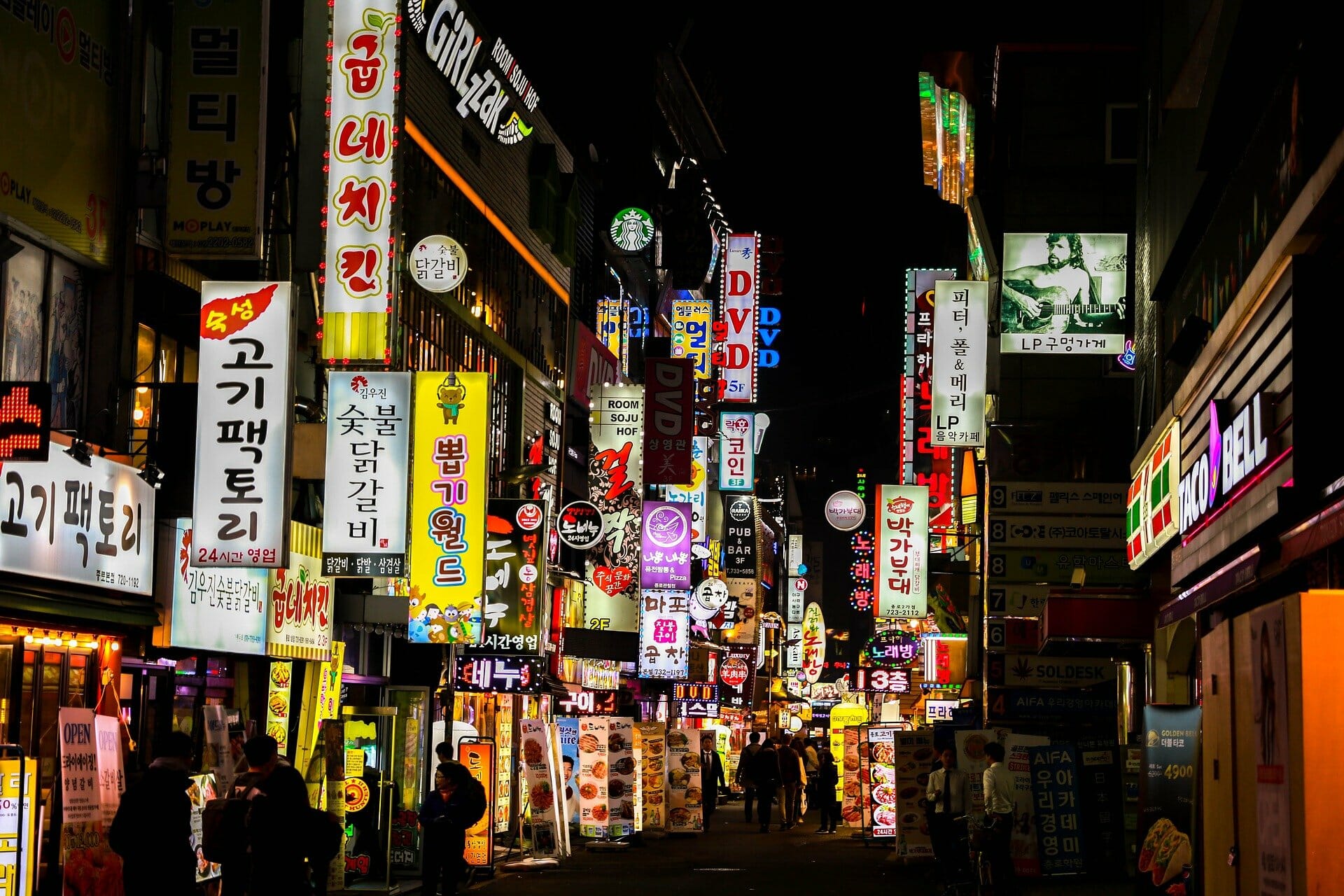
62. How much is (item)? – (item) 얼마에요? – (item) eol-ma-e-yo
얼마에요 literally means ‘how much’ and this word can be used with any item to ask how much it costs. This is one of the best phrases to know when you visit Korea and it’s invaluable.
63. Do you have (item)? – (item) 이 있나요? – (item) I iss-na-yo
64. Where can I buy (item)? – (item) 어디서 살 수 있나요? – (item) eo-di-seo sal su iss-na-yo
If you visit a store but it doesn’t have the item that you need you can ask where you can find the missing item. Otherwise, if you are struggling to find a specific store you can always ask someone on the street!
65. Please give me a receipt – 영수증 좀 주세요 – yeong-su-jeung jom ju-se-yo
While receipts may seem like a thing of the past for many people, there’s an important caveat here. Receipts are often needed for tax-returns if you are looking to shop at duty-free stores. For this reason, knowing the Korean phrase to ask for a receipt is very handy.
66. I need a bag – 봉지 좀 주세요 – bong-ji jom ju-se-yo
If you need a bag to carry your purchases in you can use 봉지 좀 주세요. Keep in mind that this sentence just applies to plastic bags.
67. Can I pay with cash? – 현금으로 계산해도 되나요? – hyeon-geum-eu-ro gye-san-hae-do dwi-na-yo
68. Can I pay with card? – 카드로 계산해도 되나요? – ka-deu-ro gye-san-hae-do dwi-na-yo
69. Do you have a bigger size? – 더 큰 사이즈가 있나요? – deo keun sa-i-jeu-ga iss-na-yo
70. Do you have a smaller size? – 더 작은 사이즈가 있나요? – deo jag-eun sa-i-jeu-ga iss-na-yo
71. Do you have a different colour? – 다른 색깔이 있나요? – da-reun saeg-ggal-i iss-na-yo
72. It’s too expensive – 너무 비싸요 – neo-mu bi-ssa-yo
너무 비싸요 may seem a bit rude at first, but it does have some usefulness. While most stores in Korea have fixed prices, you may also find yourself shopping at markets. If you do find yourself at a market such as Namdaemun, Yongsan, or Gwangjang some of the prices are somewhat flexible. In these cases, the phrase 너무 비싸요 may lead to a drop in prices.
73. I will think about it – 생각해볼게요 – saeng-gak-hae-bol-ge-yo
We’ve all had that experience where a shop assistant won’t leave you alone! If this happens in Korea you can say 생각해볼게요 – I will think about it. This should let you escape the store and allows for more time to think.
74. Is this for sale? – 이거 파는건가요? – I-goe pa-neun-geon-ga-yo
75. Is cash cheaper? – 현금 계산은 더 싼가요? – hyeon-geum gye-san-eun deo ssan-ga-yo
‘현금 계산은 더 싼가요?’ may seem like a bit of an odd question to ask, but it’s especially useful in markets. Often, markets in Korea will offer a 10% discount to those who use cash. This is especially true in Yongsan electronics market. If you are shopping at a market it’s worth asking ‘현금 계산은 더 싼가요?’ to see if you can get the 10% discount!
76. I am just looking – 그냥 좀 보는 중이에요 – gue-nyang jom bo-neun jung-i-e-yo
Simile to point 73, this one can help you escape from a store if you are feeling pressured.
77. Where is a (blank) store? – (blank) 가게는 어디에 있나요? – (blank) ga-ge-neun eo-di-e iss-na-yo
78. Can I try this on? – 이거 입어봐도 되나요? – I-goe ib-eo-bwa-do dwi-na-yo
79. Please give me a discount – 가격을 깎아 주세요 – ga-gyeog-eul ggagg-a ju-se-yo
가격을 깎아 주세요 is not something that you would usually ask in stores, but as with some of the other Korean phrases on this list, it can work great at markets. Often sellers can drop their price by 5-10% and asking for a discount may save you a bit of money!
80. Please give me (number) – (number)개 주세요 – (number)gae ju-se-yo
If you want more than one of something, you can ask for (number) + 개 주세요. For example, if I wanted to buy three pencils I could say 연필 3개 주세요 (yeon-pil sam-gae ju-se-yo). While Korean has different counters for animals, glasses, people and more, 개 is the easiest counter to learn and people will understand if you use it.
The numbers that you should use for this sentence are actually a bit different from the numbers that are used to introduce your age. You can use the numbers from the table below followed by 개 주세요 to indicate how many of an item you would like!
Korean Numbers 1-10
| 1 | 일 | il |
| 2 | 이 | I (ee) |
| 3 | 삼 | sam |
| 4 | 사 | sa |
| 5 | 오 | o |
| 6 | 육 | yug |
| 7 | 칠 | cil |
| 8 | 팔 | pal |
| 9 | 구 | gu |
| 10 | 십 | sib |
Learn More Korean Words & Phrases

I hope that this list has helped you pick up some basic Korean phrases for traveling and living in Korea. However, this list is far from exhaustive. If you are going to visit Korea for a longer time, or if you want to practice more Korean then I highly recommend studying some more Korean. There are many great platforms that will help you study Korean.
For anyone seriously wanting to study Korean (even if only to pick up the basics) I recommend checking out 90 Day Korean. They offer a strong curriculum and aim to allow users to have a basic conversation within 3 months. In conjunction with a memorisation platform such as Glossika you can pick up the basics of Korean in no time!

Essential Korean Travel Phrases FAQ
What Are the 5 Most Important Korean Travel Phrases?
Give me _____ = _____ 주세요 = _____ ju-sae-yo
How much does _____ cost? = _____ 얼마에요? = _____ eol-ma-e-yo?
Where is _____? = _____ 가 어디에 있나요? = _____ ga eo-di-e iss-na-yo?
Do you have _____? = _____ 이 있나요? = _____ i iss-na-yo?
How can I get to _____? = _____ 에 어떻게 가나요? = _____ e eo-deoh-ge ga-na-yo?
What Korean Phrases Do I Need for Ordering Food?
Do you have _____? = _____ 이 있나요? = _____ i iss-na-yo?
Give me _____ = _____ 주세요 = _____ ju-sae-yo
I would like take-out = 포장해주세요 = po-jang-hae-ju-sae-yo
Excuse me (for service) = 저기요 = Jeo-gi-yo
How Can I Learn More Korean?
If you are looking to learn more Korean past basic phrases then I recommend checking out this post on the best ways to learn Korean.
Do I Need to Learn Korean Before Visiting Korea?
It isn’t essential to learn Korean before visiting Korea. However, learning even basic Korean will make your trip that much better. Not only will it make communication easier, but it’s always polite to learn the language of the country that you are visiting.
What Korean Phrases Do I Need for Shopping?
Give me _____ = _____ 주세요 = _____ ju-sae-yo
How much does _____ cost? = _____ 얼마에요? = _____ eol-ma-e-yo?
Do you have _____? = _____ 이 있나요? = _____ i iss-na-yo?
Where can I buy _____? = _____ 어디서 살 수 있나요? = _____ eo-di-seo sal su iss-na-yo?
What Korean Phrases Do I Need for Introducing Myself?
Nice to meet you = 만나서 반갑습니다 = man-na-seo ban-gab-seub-ni-da
My name is _____ = 제 이름은 _____ 입니다 = je i-reum-eun _____ ib-ni-da
I am from _____ = 저는 _____ 에서 왔어요 = joe-neun _____ e-seo wass-eo-yo
I am _____ years old = _____ 살 입니다 = _____ sal ib-ni-da
